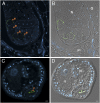Multiple lateral gene transfers and duplications have promoted plant parasitism ability in nematodes
- PMID: 20876108
- PMCID: PMC2955110
- DOI: 10.1073/pnas.1008486107
Multiple lateral gene transfers and duplications have promoted plant parasitism ability in nematodes
Abstract
Lateral gene transfer from prokaryotes to animals is poorly understood, and the scarce documented examples generally concern genes of uncharacterized role in the receiver organism. In contrast, in plant-parasitic nematodes, several genes, usually not found in animals and similar to bacterial homologs, play essential roles for successful parasitism. Many of these encode plant cell wall-degrading enzymes that constitute an unprecedented arsenal in animals in terms of both abundance and diversity. Here we report that independent lateral gene transfers from different bacteria, followed by gene duplications and early gain of introns, have shaped this repertoire. We also show protein immunolocalization data that suggest additional roles for some of these cell wall-degrading enzymes in the late stages of these parasites' life cycle. Multiple functional acquisitions of exogenous genes that provide selective advantage were probably crucial for the emergence and proficiency of plant parasitism in nematodes.
Conflict of interest statement
The authors declare no conflict of interest.
Figures



References
-
- Boucher Y, et al. Lateral gene transfer and the origins of prokaryotic groups. Annu Rev Genet. 2003;37:283–328. - PubMed
-
- Hotopp JC, et al. Widespread lateral gene transfer from intracellular bacteria to multicellular eukaryotes. Science. 2007;317:1753–1756. - PubMed
-
- Gladyshev EA, Meselson M, Arkhipova IR. Massive horizontal gene transfer in bdelloid rotifers. Science. 2008;320:1210–1213. - PubMed
-
- Bakhetia M, Urwin PE, Atkinson HJ. QPCR analysis and RNAi define pharyngeal gland cell-expressed genes of Heterodera glycines required for initial interactions with the host. Mol Plant Microbe Interact. 2007;20:306–312. - PubMed
Publication types
MeSH terms
Substances
LinkOut - more resources
Full Text Sources

